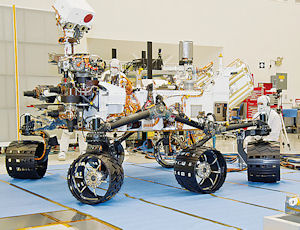When the rover Curiosity lands on Mars this month it will be powered by a generator carrying plutonium with origins in the San Fernando Valley. Canoga Park-based Hamilton Sundstrand Rocketdyne designed and built the power source, officially named the Multi-Mission Radioisotope Thermoelectric Generator, and conducted some of the development and testing locally. Teledyne Energy Systems, a subsidiary of Thousand Oaks-based Teledyne Technologies Corp., provided the thermoelectric materials and core power generator components. By using a nuclear-powered generator, Curiosity has advantages over the previous two solar-powered rovers, Opportunity and Spirit, which landed in 2004. Curiosity, for instance, is not affected by bad weather or dust storms which block out the sun on the red planet’s surface. And the vehicle — about the size of a MINI Cooper — can travel into deep canyons where natural light does not penetrate. “You want to get into places where there is interesting information hidden from you in the shade,” said David Woerner, the office manager for the generator project at the Jet Propulsion Laboratory (JPL) in La Cañada-Flintridge, which oversees deep space and planetary exploration for NASA. Curiosity was launched in November for an eight-month journey to Mars where the craft will study the habitability of the planet and test rocks and soil in an on-board laboratory. It is scheduled to land on Aug. 6. Other Valley companies, including Canoga Park rocket maker Pratt & Whitney Rocketdyne and Bohemian Grey, a Granada Hills animation and visualization firm, were involved in the Curiosity space exploration project. Pratt & Whitney Rocketdyne developed and built the rocket carrying the rover. Both Pratt & Whitney Rocketdyne and HS-Rocketdyne are owned by United Technologies Corp. and share space in a campus on DeSoto Avenue. Kevin Lane and his team at Bohemian Grey created an animated film depicting how the rover will land and operate on Mars for the JPL website. ‘No off switch’ For Rocketdyne engineers and technicians, the Mars rover program represents a first for the company. “While we have launched just about everything, this is the first piece of Rocketdyne hardware to land on Mars,” said Karl Wefers, chief engineer for HS-Rocketdyne. The heat generated by the decaying plutonium is turned into electricity to operate the cameras, arms, wheels and other motors. Exchangers on the back of the rover also capture the heat, which warms up a fluid that gets distributed around the vehicle through tubes to keep it warm, acting much like an old-fashioned radiator system. There are no lights on Curiosity, so during the Martian night, it takes a snooze while its batteries are recharged. Those batteries will operate until the plutonium is depleted, which will outlast the lifespan of the vehicle itself, Woerner said. “There is no off switch,” Woerner said. “It will go until it stops.” The U.S. Department of Energy awarded the generator contract in 2003 to HS-Rocketdyne and Teledyne Energy Systems; at the time, the contract was valued at $50 million over a 10-year period. Design review and initial testing of the rover were done in Canoga Park. There were discussions between HS-Rocketdyne and JPL (Jet Propulsion Laboratory) engineers on every aspect of the project — from how the generator should be mounted to the fluid loops that heat the electronic equipment to the best color for the generator. “We had to have all those conversations and those went on for a long time until we got it straight,” Woerner said. The design of the generator was completed in 2007 and the first production model was delivered a year later. The Energy Department installed the plutonium fuel at a facility in Idaho. After another series of tests and reviews, the generator was installed into the Curiosity. “We supported the integration with the folks from JPL,” said Bill Otting, program manager for the HS-Rocketdyne generator. Milestone mission Those who worked closely on the nine-year project — including Wefers, Otting, and Larry Trager, general manager of HS-Rocketdyne — attended the launch last year and now anxiously await Curiosity’s landing. “This is a milestone,” Trager said. “After all these years… we’ll see the fruits of our labors.” Lane and the team at Bohemian Grey share the enthusiasm. “We’re all on the edge of our seats,” Lane said. “If all goes well, we are in for some exciting results from the rover.” JPL asked Lane to make a 30-second trailer using portions of the animated film that can screen at planetariums during public events connected with Curiosity’s descent. More work may come the firm’s way as the rover explores the planet. “As long as there is a story to tell there will be stuff to depict,” Lane said. “(Our film) is the only way to see the rover on the surface in the third person.” And Mars may not be the last stop for the HS-Rocketdyne generator. With “multi-mission” in its name, the model generator can be used for deep space missions and to explore nearby planets. A radioisotope thermoelectric generator powered the Viking 1 and Viking 2 Mars exploration vehicles in the 1970s. Making the generator white was a nod to future missions, as the color reflects the heat of the sun away from the device, Woerner said. There is one other completed generator and a third in the assembly stage, Trager said. Whether they get used is up to Congress, which sets the NASA budget. “We believe after Aug. 5 there will be more excitement and more interest (in space exploration),” Trager said.
